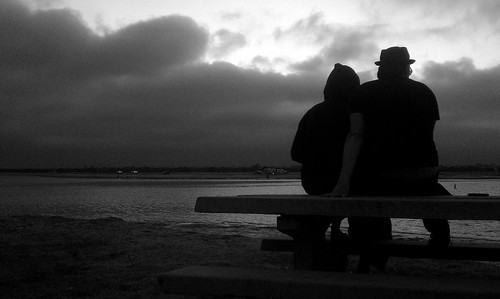 I sat in on a seminar recently with a room full of moms. Moms of babies, moms of toddlers, moms with children just starting elementary school. The topic was about learning to fall in love with your husband again, and the speaker was a woman in her 70’s. The dialog was mainly, “Do this to keep your husband happy, do that to keep your husband happy…” I think many were wondering why they got up early on a Tuesday morning to listen to old-fashion marriage advice. However, in between the eye rolls of many overtired moms, I caught the true message of the speech – don’t forget about your marriage, the kids are wonderful, but if you make them your whole world, they leave the nest, and the marriage is over.
I had not really thought about empty nest syndrome in this sense. I had mainly thought about the kids going off to college and the parents are alone in a big empty house, they are a little lonely, maybe start a new hobby, and life goes on. Only life doesn’t go on, at least not in that sense. Divorce after decades, the graying divorce, divorce after 50, whatever you may call it, is becoming more and more common. Decades of putting the kids first, likely putting the career second, and well, the marriage must have fallen down on the priority list.
When children are babies and toddlers they require about every last bit of energy you have; once they start school it’s homework, sports, and juggling schedules. Making it all too easy for the better part of 20+ years for your marriage to be entirely kid-centric. The graying divorce gives new meaning to staying together for the kids. The couple in many of these marriages might not have even seen it coming. Years of enjoying the children together – family vacations, neighborhood outings, cheering the kids on together from the sidelines, only to wake up one day and realize they no longer have anything in common, the kids were all they had in common.
A half-century ago, only 2.8 percent of Americans older than 50 were divorced. In 2011, according to the Census Bureau’s American Community Survey, 15.4 percent were divorced and another 2.1 percent were separated. Was it that divorce was more taboo 50 years ago, or maybe because people are living longer these days? A healthy 60 year old might look at it in terms of having 20+ years left; 20+ years that they are choosing to be happy, and ditching the unhappy marriage. Baby boomers are setting record high divorce numbers.
If you found yourself amongst this new era of divorce, the good news is you are in good company! There are support groups nationwide that are catering specifically to the increase in baby boomers and their graying divorces. Seek out divorcees going through a similar situation and create a support system. Most importantly, keep on living – enjoying yourself, pursue your interests, take on a new hobby, travel, and make the most of your new-found free time!
I sat in on a seminar recently with a room full of moms. Moms of babies, moms of toddlers, moms with children just starting elementary school. The topic was about learning to fall in love with your husband again, and the speaker was a woman in her 70’s. The dialog was mainly, “Do this to keep your husband happy, do that to keep your husband happy…” I think many were wondering why they got up early on a Tuesday morning to listen to old-fashion marriage advice. However, in between the eye rolls of many overtired moms, I caught the true message of the speech – don’t forget about your marriage, the kids are wonderful, but if you make them your whole world, they leave the nest, and the marriage is over.
I had not really thought about empty nest syndrome in this sense. I had mainly thought about the kids going off to college and the parents are alone in a big empty house, they are a little lonely, maybe start a new hobby, and life goes on. Only life doesn’t go on, at least not in that sense. Divorce after decades, the graying divorce, divorce after 50, whatever you may call it, is becoming more and more common. Decades of putting the kids first, likely putting the career second, and well, the marriage must have fallen down on the priority list.
When children are babies and toddlers they require about every last bit of energy you have; once they start school it’s homework, sports, and juggling schedules. Making it all too easy for the better part of 20+ years for your marriage to be entirely kid-centric. The graying divorce gives new meaning to staying together for the kids. The couple in many of these marriages might not have even seen it coming. Years of enjoying the children together – family vacations, neighborhood outings, cheering the kids on together from the sidelines, only to wake up one day and realize they no longer have anything in common, the kids were all they had in common.
A half-century ago, only 2.8 percent of Americans older than 50 were divorced. In 2011, according to the Census Bureau’s American Community Survey, 15.4 percent were divorced and another 2.1 percent were separated. Was it that divorce was more taboo 50 years ago, or maybe because people are living longer these days? A healthy 60 year old might look at it in terms of having 20+ years left; 20+ years that they are choosing to be happy, and ditching the unhappy marriage. Baby boomers are setting record high divorce numbers.
If you found yourself amongst this new era of divorce, the good news is you are in good company! There are support groups nationwide that are catering specifically to the increase in baby boomers and their graying divorces. Seek out divorcees going through a similar situation and create a support system. Most importantly, keep on living – enjoying yourself, pursue your interests, take on a new hobby, travel, and make the most of your new-found free time!  I sat in on a seminar recently with a room full of moms. Moms of babies, moms of toddlers, moms with children just starting elementary school. The topic was about learning to fall in love with your husband again, and the speaker was a woman in her 70’s. The dialog was mainly, “Do this to keep your husband happy, do that to keep your husband happy…” I think many were wondering why they got up early on a Tuesday morning to listen to old-fashion marriage advice. However, in between the eye rolls of many overtired moms, I caught the true message of the speech – don’t forget about your marriage, the kids are wonderful, but if you make them your whole world, they leave the nest, and the marriage is over.
I had not really thought about empty nest syndrome in this sense. I had mainly thought about the kids going off to college and the parents are alone in a big empty house, they are a little lonely, maybe start a new hobby, and life goes on. Only life doesn’t go on, at least not in that sense. Divorce after decades, the graying divorce, divorce after 50, whatever you may call it, is becoming more and more common. Decades of putting the kids first, likely putting the career second, and well, the marriage must have fallen down on the priority list.
When children are babies and toddlers they require about every last bit of energy you have; once they start school it’s homework, sports, and juggling schedules. Making it all too easy for the better part of 20+ years for your marriage to be entirely kid-centric. The graying divorce gives new meaning to staying together for the kids. The couple in many of these marriages might not have even seen it coming. Years of enjoying the children together – family vacations, neighborhood outings, cheering the kids on together from the sidelines, only to wake up one day and realize they no longer have anything in common, the kids were all they had in common.
A half-century ago, only 2.8 percent of Americans older than 50 were divorced. In 2011, according to the Census Bureau’s American Community Survey, 15.4 percent were divorced and another 2.1 percent were separated. Was it that divorce was more taboo 50 years ago, or maybe because people are living longer these days? A healthy 60 year old might look at it in terms of having 20+ years left; 20+ years that they are choosing to be happy, and ditching the unhappy marriage. Baby boomers are setting record high divorce numbers.
If you found yourself amongst this new era of divorce, the good news is you are in good company! There are support groups nationwide that are catering specifically to the increase in baby boomers and their graying divorces. Seek out divorcees going through a similar situation and create a support system. Most importantly, keep on living – enjoying yourself, pursue your interests, take on a new hobby, travel, and make the most of your new-found free time!
I sat in on a seminar recently with a room full of moms. Moms of babies, moms of toddlers, moms with children just starting elementary school. The topic was about learning to fall in love with your husband again, and the speaker was a woman in her 70’s. The dialog was mainly, “Do this to keep your husband happy, do that to keep your husband happy…” I think many were wondering why they got up early on a Tuesday morning to listen to old-fashion marriage advice. However, in between the eye rolls of many overtired moms, I caught the true message of the speech – don’t forget about your marriage, the kids are wonderful, but if you make them your whole world, they leave the nest, and the marriage is over.
I had not really thought about empty nest syndrome in this sense. I had mainly thought about the kids going off to college and the parents are alone in a big empty house, they are a little lonely, maybe start a new hobby, and life goes on. Only life doesn’t go on, at least not in that sense. Divorce after decades, the graying divorce, divorce after 50, whatever you may call it, is becoming more and more common. Decades of putting the kids first, likely putting the career second, and well, the marriage must have fallen down on the priority list.
When children are babies and toddlers they require about every last bit of energy you have; once they start school it’s homework, sports, and juggling schedules. Making it all too easy for the better part of 20+ years for your marriage to be entirely kid-centric. The graying divorce gives new meaning to staying together for the kids. The couple in many of these marriages might not have even seen it coming. Years of enjoying the children together – family vacations, neighborhood outings, cheering the kids on together from the sidelines, only to wake up one day and realize they no longer have anything in common, the kids were all they had in common.
A half-century ago, only 2.8 percent of Americans older than 50 were divorced. In 2011, according to the Census Bureau’s American Community Survey, 15.4 percent were divorced and another 2.1 percent were separated. Was it that divorce was more taboo 50 years ago, or maybe because people are living longer these days? A healthy 60 year old might look at it in terms of having 20+ years left; 20+ years that they are choosing to be happy, and ditching the unhappy marriage. Baby boomers are setting record high divorce numbers.
If you found yourself amongst this new era of divorce, the good news is you are in good company! There are support groups nationwide that are catering specifically to the increase in baby boomers and their graying divorces. Seek out divorcees going through a similar situation and create a support system. Most importantly, keep on living – enjoying yourself, pursue your interests, take on a new hobby, travel, and make the most of your new-found free time! 



